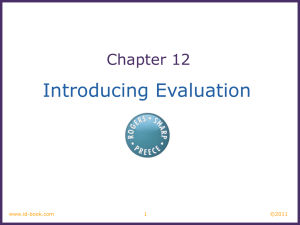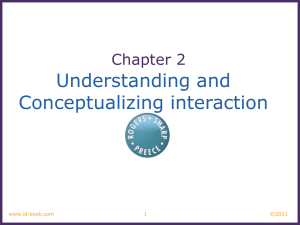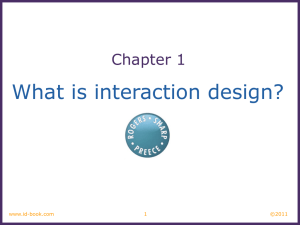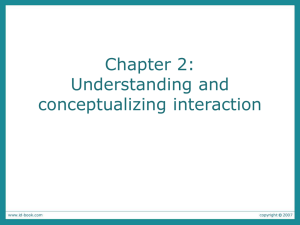Commun. ACM - Faculty of Computer Science
advertisement
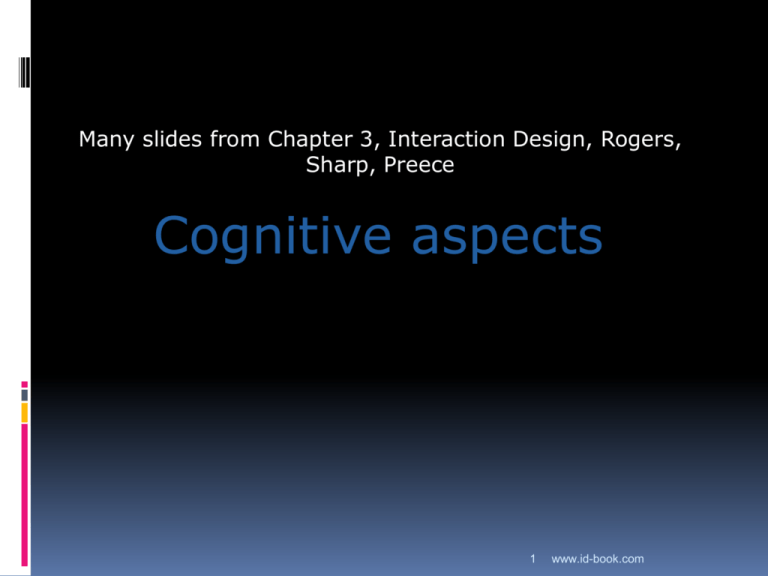
Many slides from Chapter 3, Interaction Design, Rogers, Sharp, Preece Cognitive aspects 1 www.id-book.com Why do we need to understand users’ cognitive processes? Interacting with technology is cognitive Need to take into account cognitive processes involved and cognitive limitations of users Provides knowledge about what users can and cannot be expected to do Identifies and explains the nature and causes of problems users encounter Supply theories, modelling tools, guidance and methods that can lead to the design of better interactive products 2 www.id-book.com ©2011 Cognitive processes Memory Attention Perception and recognition External cognitive processes Problem-solving, planning, reasoning and decision- making Learning Reading, speaking and listening 3 www.id-book.com ©2011 Challenge to you As you research your special topics, think about the underlying cognitive processes and theories that impact user experience in that area Include a slide reflecting upon these in your presentation 4 www.id-book.com ©2011 MEMORY 5 www.id-book.com Memory Involves first encoding and then retrieving knowledge We don’t remember everything - involves filtering and processing what is attended to Context is important in affecting our memory (i.e. where, when) We recognize things much better than being able to recall things 6 www.id-book.com ©2011 Processing in memory Encoding is first stage of memory determines which information is attended to in the environment and how it is interpreted The more attention paid to something… The more it is processed in terms of thinking about it and comparing it with other knowledge… The more likely it is to be remembered e.g. when learning about HCI, it is much better to reflect upon it, carry out exercises, have discussions with others about it, and write notes than just passively read a book, listen to a lecture or watch a video about it 7 www.id-book.com ©2011 Context is important Context affects the extent to which information can be subsequently retrieved Sometimes it can be difficult for people to recall information that was encoded in a different context: “You are on a train and someone comes up to you and says hello. You don’t recognize him for a few moments but then realize it is one of your neighbors. You are only used to seeing your neighbor in the hallway of your apartment block and seeing him out of context makes him difficult to recognize initially” 8 www.id-book.com ©2011 Activity Try to remember the dates of your grandparents’ birthday Try to remember the cover of the last two DVDs you bought or rented Which was easiest? Why? People are very good at remembering visual cues about things e.g. the color of items, the location of objects and marks on an object They find it more difficult to learn and remember arbitrary material e.g. birthdays and phone numbers 9 www.id-book.com ©2011 Recognition versus recall Command-based interfaces require users to recall from memory a name from a possible set of 100s GUIs provide visually-based options that users need only browse through until they recognize one Web browsers, MP3 players, etc., provide lists of visited URLs, song titles etc., that support recognition memory 10 www.id-book.com ©2011 Activity 3, 12, 6, 20, 9, 4, 0, 1, 19, 8, 97, 13, 84 Cat, house, paper, laugh, people, red, yes, number, shadow, broom, rain, plant, lamp, chocolate, radio, one, coin, jet t, k, s, y, r, q, x, p, z, a, l, b, m, e 11 www.id-book.com ©2011 The problem with the classic ‘72’ George Miller’s (1956) theory of how much information people can remember People’s immediate memory capacity is very limited Many designers think this is useful finding for interaction design But… 12 www.id-book.com ©2011 What some designers get up to… Present only 7 options on a menu Display only 7 icons on a tool bar Have no more than 7 bullets in a list Place only 7 items on a pull down menu Place only 7 tabs on the top of a website page But this is wrong? Why? 13 www.id-book.com ©2011 Why? Inappropriate application of the theory People can scan lists of bullets, tabs, menu items for the one they want They don’t have to recall them from memory having only briefly heard or seen them Sometimes a small number of items is good But depends on task and available screen estate 14 www.id-book.com ©2011 Design implications Don’t overload users’ memories with complicated procedures for carrying out tasks Design interfaces that promote recognition rather than recall Provide users with various ways of encoding information to help them remember e.g. categories, color, flagging, time stamping 15 www.id-book.com ©2011 Personal information management Personal information management is a growing problem for many users vast numbers of documents, images, music files, video clips, emails, attachments, bookmarks, etc., where and how to save them all, then remembering what they were called and where to find them again naming most common means of encoding them but can be difficult to remember, especially when have 1000s and 1000s How might such a process be facilitated taking into account people’s memory abilities? 16 www.id-book.com ©2011 Personal information management Memory involves 2 processes recall-directed and recognition-based scanning File management systems should be designed to optimize both kinds of memory processes e.g. Search box and history list Help users encode files in richer ways Provide them with ways of saving files using colour, flagging, image, flexible text, time stamping, etc 17 www.id-book.com ©2011 What are the pros and cons of Apple’s Spotlight search? 18 www.id-book.com ©2011 ATTENTION 19 www.id-book.com Activity Video: http://viscog.beckman.illinois.edu/flashmovie /15.php 20 www.id-book.com ©2011 Attention Selecting things to concentrate on at a point in time from the mass of stimuli around us Allows us to focus on information that is relevant to what we are doing Involves audio and/or visual senses Focussed and divided attention enables us to be selective in terms of the mass of competing stimuli but limits our ability to keep track of all events Information at the interface should be structured to capture users’ attention, e.g. use perceptual boundaries (windows), colour, sound and flashing ©2011 lights 21 www.id-book.com Activity: Find the price of a double room at the Holiday Inn in Bradley 22 www.id-book.com ©2011 Activity: Find the price for a double room at the Quality Inn in Columbia 23 www.id-book.com ©2011 Activity Tullis (1987) found that the two screens produced quite different results 1st screen - took an average of 5.5 seconds to search 2nd screen - took 3.2 seconds to search Why, since both displays have the same density of information (31%)? Spacing and organization In the 1st screen the information is bunched up together, making it hard to search In the 2nd screen the characters are grouped into vertical categories of information making it easier ©2011 24 www.id-book.com Multitasking and attention Is it possible to perform multiple tasks without one or more of them being detrimentally affected? Ophir et al (2009) compared heavy vs light multitaskers heavy were more prone to being distracted by multiple streams of media than those who infrequently multitask heavy multi-taskers are easily distracted and find it difficult to filter irrelevant information 25 www.id-book.com ©2011 26 www.id-book.com Design implications for attention Make information salient when it needs attending to Use techniques that make things stand out like color, ordering, spacing, underlining, sequencing and animation Avoid cluttering the interface with too much information Avoid using too much because the software allows it 27 www.id-book.com ©2011 Reading Eric Horvitz, Carl Kadie, Tim Paek, and David Hovel. 2003. Models of attention in computing and communication: from principles to applications. Commun. ACM 46, 3 (March 2003), 52-59. http://research.microsoft.com/enus/um/people/horvitz/cacmattention.pdf (many more related publications on this page) 28 www.id-book.com ©2011 Questions What is this paper about? How do the researchers apply existing models/theories? How are they contributing to the theory? 29 www.id-book.com ©2011 Discussion Self-interruption vs. directed interruptions What notifications do you use? What have you turned off? What do you think is missing? 30 www.id-book.com ©2011 Coordinating Interruptions People don’t recover well from interruptions 4 ways of coordinating user interruptions Immediate: interrupt at any time Negotiated: announce need, negotiate interrupt Mediated: let another device schedule interruptions Scheduled: pre-arranged schedule Automation deficit: initial decrease in performance when trying to resume task ©2011 Effects of Coordination Strategies Different approaches have different pros and cons People perform well when they can negotiate for the onset of interruptions, but they don’t handle interruptions in a timely way When people are forced to handle interruptions immediately, they handle them promptly but make more mistakes and are less effective overall ©2011 Attention Attention is the critical resource we should consider There are many cues about attention, but none of them provide certainty Can use an academic model to reason about attention while considering uncertainty Cost-benefit trade-off Balance expected value of information with the attention-sensitive costs of disruption ©2011 Attention (cont.) Bounded deferral: central system passes alert to device, device makes local decision about when to interrupt (within time limit) ©2011 Communication channels 35 www.id-book.com ©2011 36 www.id-book.com ©2011 Communication Channels http://www.chrisbrogan.com/communication -tools-and-levels-of-interruption/ Email Tweet SMS Text Messaging Phone Calls As a sender, what makes you choose a channel? As a receiver, what is the impact? 37 www.id-book.com ©2011 Communication models Cranor, L. 2008. A Framework for Reasoning about the Human in the Loop.http://www.usenix.org/event/upsec08/t ech/full_papers/cranor/cranor.pdf The following slides are from her talk on the paper 38 www.id-book.com ©2011 Privacy & Security Cues Cookie flag Netscape SSL icons IE6 cookie flag Firefox SSL icon 39 C-HIP Model CommunicationHuman Information Processing (C-HIP) Model Wogalter, M. 2006. Communication-Human Information Processing (CHIP) Model. In Wogalter, M., ed., Handbook of Warnings. Lawrence Erlbaum Associates, Mahwah, NJ, 5161. 40 How do we know if a security or privacy cue is usable? Evaluate it Why is it there? Do users notice it? Do they know what it means? Do they know what they are supposed to do when they see it? Will they actually do it? Will they keep doing it? Cranor, L. F. 2006. What do they "indicate?": evaluating security and privacy indicators. interactions 13, 3 (May. 2006), 45-47. ©2011 Do users notice it? If users don’t notice indicator all bets are off “What lock icon?” Few users notice lock icon in browser chrome, https, etc. C-HIP model: Attention switch, attention maintenance ©2011 42 43 Do users know what it means? Web browser lock icon: “I think that it means secured, it symbolizes some kind of security, somehow.” Web browser security pop-up: “Yeah, like the certificate has expired. I don’t actually know what that means.” C-HIP Model: Comprehension/Memory J. Downs, M. Holbrook, and L. Cranor. Decision Strategies and Susceptibility to Phishing. In Proceedings of the 2006 Symposium On Usable Privacy and Security, 12-14 July 2006, Pittsburgh, PA. ©2011 44 Do users know what to do when they see it? Developers should not expect users to make decisions they themselves can’t make Present choices, not dilemmas C-HIP Model: Comprehension/Memory ©2011 45 Example: Certificate warnings 46 ©2011 Users Don’t Check Certificates ©2011 48 ©2011 49 ©2011 Do users believe the indicator? “Oh yeah, I have [seen warnings], but funny thing is I get them when I visit my [school] websites, so I get told that this may not be secure or something, but it’s my school website so I feel pretty good about it.” C-HIP Model: Attitudes/Beliefs 50 ©2011 Are users motivated to take action? May view risk as minimal May find recommended action too inconvenient or difficult C-HIP Model: Motivation ©2011 51 Do they actually do it? “I would probably experience some brief, vague sense of unease and close the box and go about my business.” Admonishing users or giving them rules they don’t know how to follow is usually not helpful. We need to find ways to make it easy for users to do the right thing C-HIP Model: Behavior ©2011 52 Do they keep doing it? Difficult to measure in laboratory setting Need to collect data on users in natural environment over extended period of time C-HIP Model: Behavior ©2011 53 How does it interact with other indicators? Indicator overload? ©2011 54 55 Summary: Usability evaluation Do users notice it? Do they know what it means? Do they know what they are supposed to do when they see it? Do they believe it? Are they motivated to do it? Will they actually do it? Will they keep doing it? How does it interact with 56 other indicators? Human in the Loop Security Framework Communication Impediments Environmental Stimuli Knowledge and Experience Communication Interference Intentions Attitudes and Beliefs Cranor, L. F. 2008. A framework for reasoning about the human in the loop. In Proc. of the 1st Conference on Usability, Psychology, and Security, 1-15. Motivation Capabilities 57 Communication Processing Demographics and Personal Characteristics Application Personal Variables Communication Delivery Human Receiver Attention Switch Attention Maintenance Comprehension Behavior Knowledge Acquisition Knowledge Retention Knowledge Transfer ©2011 How to use the model? Critiquing an interface Designing a user study If you want to evaluate whether users can comprehend the warning information? If you want to evaluate whether users will notice the information? If you want to understand how behaviour correlates with individual differences 58 www.id-book.com ©2011 February 12, 2013 Implications for Design Ethnographic practices in industry 2 videos Discussion of MP1 Analysis Any questions? Cognitive models 59 www.id-book.com ©2011 Mental models, external cognition COGNITION 60 www.id-book.com Cognitive modes Experiential state-of-mind associated to perception of the environment around us, and to our engagement with that environment through our actions and reactions. Reflective state-of-mind associated to higher-level processing of knowledge, memory, and external information (or stimuli) through thinking, comparing, and judging. 61 www.id-book.com ©2011 http://julioterrany.blogspot.com/2009/03/id-fmp-modes-of-cognition.html 62 ©2011 Mental models Users develop an understanding of a system through learning about and using it Knowledge is sometimes described as a mental model: How to use the system (what to do next) What to do with unfamiliar systems or unexpected situations (how the system works) People make inferences using mental models of how to carry out tasks 63 www.id-book.com ©2011 Mental models Craik (1943) described mental models as: internal constructions of some aspect of the external world enabling predictions to be made Involves unconscious and conscious processes images and analogies are activated Deep versus shallow models e.g. how to drive a car and how it works 64 www.id-book.com ©2011 Everyday reasoning and mental models (a) You arrive home on a cold winter’s night to a cold house. How do you get the house to warm up as quickly as possible? Set the thermostat to be at its highest or to the desired temperature? (b) You arrive home starving hungry. You look in the fridge and find all that is left is an uncooked pizza. You have an electric oven. Do you warm it up to 375 degrees first and then put it in (as specified by the instructions) or turn the oven up higher to try to warm it up quicker? 65 www.id-book.com ©2011 Heating up a room or oven that is thermostat-controlled Many people have erroneous mental models (Kempton, 1996) Why? General valve theory, where ‘more is more’ principle is generalised to different settings (e.g. gas pedal, gas cooker, tap, radio volume) Thermostats based on model of on-off switch model 66 www.id-book.com ©2011 Heating up a room or oven that is thermostat-controlled Same is often true for understanding how interactive devices and computers work: poor, often incomplete, easily confusable, based on inappropriate analogies and superstition (Norman, 1983) e.g. elevators and pedestrian crossings - lot of people hit the button at least twice Why? Think it will make the lights change faster or ensure the elevator arrives! 67 www.id-book.com ©2011 Exercise: How an ATM works How much money are you allowed to take out? What denominations? If you went to another machine and tried the same what would happen? What information is on the strip on your card? What happens if you enter the wrong number? Why are there pauses between the steps of a transaction? What happens if you type during them? Why does the card stay inside the machine? Do you count the money? Why? 68 www.id-book.com ©2011 How did you fare? Your mental model How accurate? How similar? How shallow? Payne (1991) did a similar study and found that people frequently resort to analogies to explain how they work People’s accounts greatly varied and were often ad hoc 69 www.id-book.com ©2011 70 www.id-book.com ©2011 Gulfs of execution and evaluation The ‘gulfs’ explicate the gaps that exist between the user and the interface The gulf of execution the distance from the user to the physical system The gulf of evaluation the distance from the physical system to the user Bridging the gulfs can reduce cognitive effort required to perform tasks ©2011 Norman, 1986; Hutchins et al, 1986 71 www.id-book.com Bridging the gulfs 72 www.id-book.com ©2011 http://julioterrany.blogspot.co m/2009/03/id-fmp-model-ofinteraction.html 73 www.id-book.com ©2011 Cognition During Interaction Attention supports all phases of interaction from perception through to action execution. This cognitive process refers to a user’s ability to focus on both external phenomena and internal thoughts. Perception given its own phase in Norman’s model. Memory plays an important role during all phases from interpretation through to action specification. 74 www.id-book.com ©2011 Cognition During Interaction Language (verbal and visual) supports communication throughout all phases of a person’s interaction with a product. Learning enables people to use new products and increase effectiveness and efficiency in their interactions with existing products. It supports all phases between the interpretation and action specification. Higher reason governs all activities related to the setting of high-level goals and intent, and driving evaluations. 75 www.id-book.com ©2011 Information processing Conceptualizes human performance in metaphorical terms of information processing stages 76 www.id-book.com ©2011 Model Human processor (Card et al, 1983) Models the information processes of a user interacting with a computer Predicts which cognitive processes are involved when a user interacts with a computer Enables calculations to be made of how long a user will take to carry out a task 77 www.id-book.com ©2011 78 www.id-book.com http://en.wikipedia.org/wik i/Human_information_pro cessor_model Provides steps for calculating how long it takes to perform a task Eye movement time: 230 ms (70-700 ms) Decay half-life of visual image storage: 200 ms (901000 ms) Visual Capacity: 17 letters (717 letters) 79 www.id-book.com ©2011 Limitations based on modelling mental activities that happen exclusively inside the head do not adequately account for how people interact with computers and other devices in real world 80 www.id-book.com ©2011 Exercise How much and what kind of cognition is involved in using an iPod or making an epurchase? 81 www.id-book.com ©2011 Cognition++ Cognition no longer limited to what’s going on within someone’s head External cognition Situated cognition Distributed cognition Collective cognition 82 www.id-book.com ©2011 External cognition Concerned with explaining how we interact with external representations (e.g. maps, notes, diagrams) What are the cognitive benefits and what processes involved How they extend our cognition What computer-based representations can we develop to help even more? 83 www.id-book.com ©2011 Externalizing reduces memory load Diaries, reminders, calendars, notes, shopping lists, to-do lists written to remind us of what to do Post-its, piles, marked emails where placed indicates priority of what to do External representations: Remind us that we need to do something (e.g. to buy something for mother’s day) Remind us of what to do (e.g. buy a card) Remind us when to do something (e.g. send a card by a certain date) 84 www.id-book.com ©2011 Computational offloading When a tool is used in conjunction with an external representation to carry out a computation (e.g. pen and paper) Try doing the two sums below (a) in your head, (b) on a piece of paper and c) with a calculator. 234 x 456 =?? CCXXXIIII x CCCCXXXXXVI = ??? Which is easiest and why? Both are identical sums 85 www.id-book.com ©2011 Annotation and cognitive tracing Annotation involves modifying existing representations through making marks e.g. crossing off, ticking, underlining Cognitive tracing involves externally manipulating items into different orders or structures e.g. playing Scrabble, playing cards 86 www.id-book.com ©2011 Design implication Provide external representations at the interface that reduce memory load and facilitate computational offloading e.g. Information visualizations have been designed to allow people to make sense and rapid decisions about masses of data 87 www.id-book.com ©2011 Problem-solving, planning, reasoning and decision-making All involves reflective cognition e.g. thinking about what to do, what the options are, and the consequences Often involves conscious processes, discussion with others (or oneself), and the use of artifacts e.g. maps, books, pen and paper May involve working through different scenarios and deciding which is best option 88 www.id-book.com ©2011 Design implications Provide additional information/functions for users who wish to understand more about how to carry out an activity more effectively Use simple computational aids to support rapid decision-making and planning for users on the move 89 www.id-book.com ©2011 Supporting decision making Active areas of research in our faculty, HCI can play a big role in the usability aspects Examples: Boeing project Interactive text analytics With Dr. Evangelos Milios, Dr. Vlado Keselj Visualization With Dr. Stephen Brooks, Dr. Dirk Arnold Personal visual analytics Providing situational awareness to sys admins 90 www.id-book.com ©2011 Distributed cognition Concerned with the nature of cognitive phenomena across individuals, artefacts, and internal and external representations (Hutchins, 1995) Describes these in terms of propagation across representational state Information is transformed through different media (computers, displays, paper, heads) 91 www.id-book.com ©2011 How it differs from information processing 92 www.id-book.com ©2011 93 www.id-book.com What’s involved The distributed problem-solving that takes place The role of verbal and non-verbal behavior The various coordinating mechanisms that are used (e.g. rules, procedures) The communication that takes place as the collaborative activity progresses How knowledge is shared and accessed 94 www.id-book.com ©2011 Other aspects of cognition Perception Learning Reading/speaking/listening Problem solving 95 www.id-book.com ©2011 Perception How information is acquired from the world and transformed into experiences Obvious implication is to design representations that are readily perceivable, e.g. Text should be legible Icons should be easy to distinguish and read 96 www.id-book.com ©2011 Is color contrast good? Find italian 97 www.id-book.com ©2011 Are borders and white space better? Find french 98 www.id-book.com ©2011 Activity Weller (2004) found people took less time to locate items for information that was grouped using a border (2nd screen) compared with using color contrast (1st screen) Some argue that too much white space on web pages is detrimental to search Makes it hard to find information Do you agree? 99 www.id-book.com ©2011 Which is easiest to read and why? What is the time? What is the time? What is the time? What is the time? What is the time? 100 www.id-book.com ©2011 Design implications Icons should enable users to readily distinguish their meaning Bordering and spacing are effective visual ways of grouping information Sounds should be audible and distinguishable Speech output should enable users to distinguish between the set of spoken words Text should be legible and distinguishable from the background 101 www.id-book.com ©2011 Learning How to learn to use a computer-based application Using a computer-based application to understand a given topic People find it hard to learn by following instructions in a manual prefer to learn by doing 102 www.id-book.com ©2011 Design implications Design interfaces that encourage exploration Design interfaces that constrain and guide learners Dynamically linking concepts and representations can facilitate the learning of complex material 103 www.id-book.com ©2011 Reading, speaking, and listening The ease with which people can read, listen, or speak differs Many prefer listening to reading Reading can be quicker than speaking or listening Listening requires less cognitive effort than reading or speaking Dyslexics have difficulties understanding and recognizing written words 104 www.id-book.com ©2011 Applications Speech-recognition systems allow users to interact with them by using spoken commands e.g. Google Voice Search app Speech-output systems use artificially generated speech e.g. written-text-to-speech systems for the blind Natural-language systems enable users to type in questions and give text-based responses e.g. Ask search engine 105 www.id-book.com ©2011 Design implications Speech-based menus and instructions should be short Accentuate the intonation of artificially generated speech voices they are harder to understand than human voices Provide opportunities for making text large on a screen 106 www.id-book.com ©2011 Summary Cognition involves several processes including attention, memory, perception and learning The way an interface is designed can greatly affect how well users can perceive, attend, learn and remember how to do their tasks Theoretical frameworks, such as mental models and external cognition, provide ways of understanding how and why people interact with products This can lead to thinking about how to design better products 107 www.id-book.com

